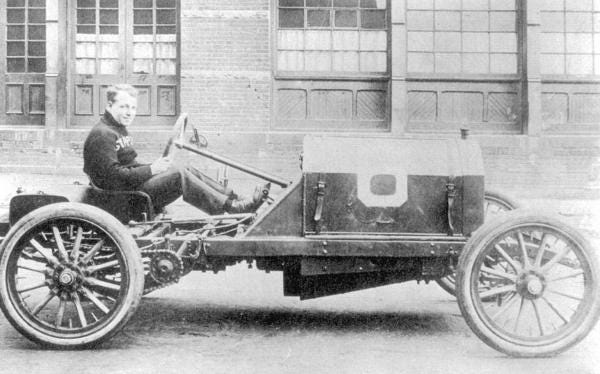The Greatest Driver Not In The First Indianapolis 500
Search
Featured Article
Image of The Week
As George Robertson entered the 1910 racing season, he easily ranked as one of America’s brightest-shining auto racing stars. He had dominated the Vanderbilt Cup, the Fairmount Park road races, set records on Daytona Beach, and was a master of the 24-hour “grinders” on dirt horse tracks.
Indeed, if racing had been more formalized in the few years he competed, George Robertson would have won championships as we understand them today. When the 40 drivers lined up for the first Indianapolis 500 the aching void in the field was that there was no George Robertson to take on Ray Harroun, Ralph Mulford, David Bruce-Brown, Joe Dawson, Ralph DePalma and the other greats.
 Driver George Robertson in his Simplex racer — 1910
Driver George Robertson in his Simplex racer — 1910
It’s not that Robertson was not up and walking around with the other living souls of the day. It’s that not unlike Gary Bettenhausen generations later, one of his arms had been severely injured in a bizarre accident during practice for the October 1910 Vanderbilt Cup — the last held on Long Island’s public roads.
While giving a newspaper reporter a hot lap of the course in the riding mechanic’s seat of his Benz racer, the man clutched him at exactly the wrong instant. The car overturned at 70 mph. The reporter was only shaken and while at first Robertson seemed to suffer only minor injuries with no broken bones. Tough guys like Robertson assumed he could shake off the numbness in his arm. It was only somehow stunned, right?
Nope.
The injury was permanent. While over the years he learned to function quite successfully in everyday life, even managing the Duesenberg team that Jimmy Murphy led to America’s greatest Grand Prix victory in 1921 he suddenly lacked the upper body strength to churn the heavy, massive steering wheels of the age. Still, like a champion, he thrived.
The Vanderbilt family hired him to revive their iconic cup race in 1936 and ’37. He oversaw the design and construction of the Roosevelt Raceway just for that purpose.
Later, he held an executive management position at Lincoln automobile and then on to Ford’s airplane business. After that, he transcended into the role of newspaper publisher overseeing the production of three Long Island papers. He closed his career as a manager for Roto Shaver.
While that may seem an odd career shift, keep in mind that the name George Robertson still carried a ton of weight up to his passing in 1955 — especially in the northeastern United States. Undoubtedly his Rolodex was “gold” as salespeople like to say.
George Robertson remains the top driver of the era not to have raced in the Indianapolis 500. He almost certainly would have been in the early fields if not for the crazy accident.
The image you see here is of Robertson sitting at the wheel of a Simplex racer he campaigned on dirt tracks during the 1910 season. He and his supporters looked ahead to the year, excited at the potential laurels. He did enjoy success in 1910 but the big black mark came with the injury that curtailed his race driving.
What you have read here is just a fraction of what you can learn about George Robertson, his life, and his times. You know what to do. Click the link at the top of this post and dive deep into the incredible time machine you know as, “First Super Speedway.”
